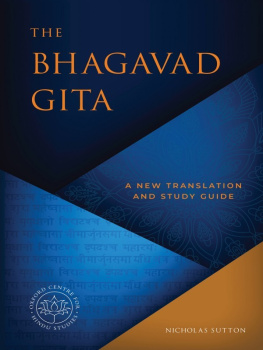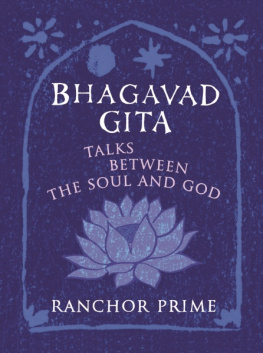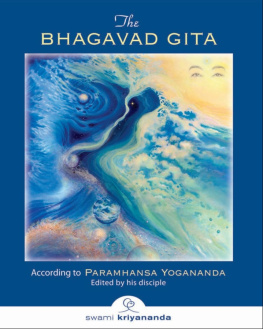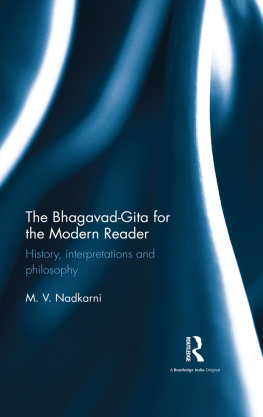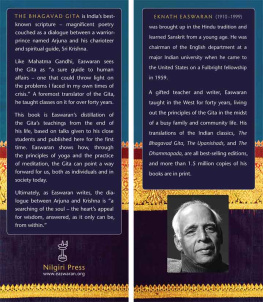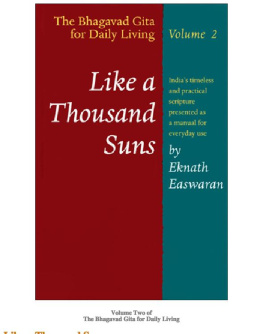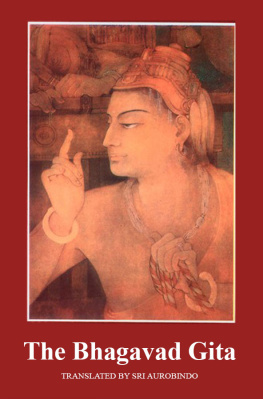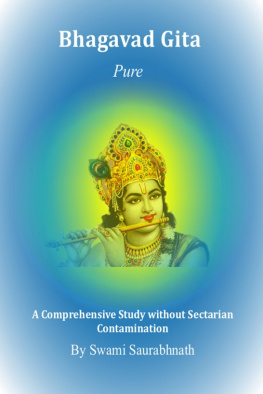Preface
I n this book, I have undertaken a detailed study of the Bhagavad-gita and the principal ideas it presents to its readers. As the Gita is a relatively short work of 18 chapters and 700 verses, it might seem that this is a far easier task than would be the case for a longer text such as the Mahabharata or the Ramayana. I have not, however, attempted a verse by verse consideration of the Bhagavad-gita and have chosen instead to adopt a thematic approach aimed at establishing and exploring the main themes of the discourse and the principal ideas presented in each chapter.
The Bhagavad-gita appears as a section of the Bhishma-parvan, the sixth book of the Mahabharata, at the point just prior to the 18-day battle at Kurukshetra. In this conflict the hopes of the Pandava faction rest largely on the martial prowess of Arjuna, the third of the five Pandava brothers. At the start of the Bhagavad-gita, however, we find the hero disconsolate and unwilling to wage war against his own family members. It is at this point that Krishna, his cousin and charioteer, begins to offer instruction to Arjuna. The initial intention of the discourse is to persuade Arjuna that waging war is not necessarily an act of wickedness, but the full treatise goes far beyond this initial thesis, developing into a thoroughgoing exposition of belief and practice that has had an immeasurable influence on the formation of Hindu religious doctrines.
I will consider the Bhagavad-gita chapter by chapter and try to establish the main ideas it pursues in its teachings, thereby seeking to identify the full significance of this famous scripture. At certain points, attention will be drawn to significant Sanskrit terms, and some use will be made of three traditional commentaries on the Gita, namely those of Shankaracharya, Ramanujacharya, and Madhvacharya. I will also try to expand the discussion so that at certain junctures it will be possible to reflect on the contemporary significance of the teachings and of how they can be of relevance to the modern world.
INTRODUCTION
A B RIEF S YNOPSIS
I n the introduction, the position of the Gita within the Mahabharata and its status within the Hindu tradition will be considered before looking briefly at some of the views of contemporary scholars. We will then turn our attention to the Gitas opening chapter with a consideration of Arjunas lamentation, which prompts Krishna to begin his teachings. Moving on to Chapter 2 we begin with a review of Krishnas initial responses to Arjunas refusal to fight and in particular the way in which he emphasises the eternal nature of the living being. We then move on to concentrate on the idea of karma-yoga, which Krishna offers as a direct response to Arjunas fear of sinful action. This notion is particularly important in Hindu religious thought, as it reveals how a person can simultaneously fulfil his social obligations whilst striving to attain the highest spiritual goals.
In considering Chapter 3 we can look in further detail at Krishnas explanation of karma-yoga and then note the progression in the teachings from karma-yoga, concluded in Chapter 5, to the explanation of dhyana presented in Chapter 6. Here, we find another form of spirituality advocated by the Bhagavad-gita, the process of meditational yoga by which one acquires direct perception of the inner self, the atman, a realisation that leads to liberation from the cycle of rebirth.
After this discussion of meditational yoga, we proceed further into the main body of our text, at this point noting how from Chapter 7 onwards the direction of the discourse changes dramatically. The opening six chapters focused on the ways in which an individual could pursue the path of renunciation whilst fulfilling social obligations, but from the beginning of Chapter 7 onwards we now find a switch in emphasis towards providing an understanding of the nature of God and of the power of divine grace. In the middle section (Chapters 712) of the Bhagavad-gita, Krishna not only teaches Arjuna about the nature of the Supreme Deity but also reveals that he himself is that Deity. And in response to Arjunas prayer, he also manifests his divine identity as that which is all things, the unseen presence of God pervading the entire creation.
After the great revelation of the divine in Chapter 11 and the emphasis placed on devotion to God, Chapters 1316 diversify the Gitas teachings and cover a variety of topics that serve to reinforce the teachings that have gone before. One common theme running through these later chapters is the emphasis on Samkhya ideas, the philosophical system that seeks to define the material manifestation and to establish the distinctive identity of the individual soul in all beings. In our sixth chapter, we will consider the ways in which Krishna employs concepts derived from the Samkhya system to add greater depth to his teachings.
In reviewing the final two chapters of the Gita (17 and 18), we again find a diversity of ideas, including an exploration of the way the gunas, the three inherent qualities of matter, can be identified within this world. The Bhagavad-gita ends its teachings by revisiting the main ideas it has presented earlier, finally concluding with a renewed emphasis on the importance of devotion and the power of divine grace in saving the devotee from rebirth.
R ECOMMENDED R EADING
The Bhagavad-gita is widely known and studied both in the West and in India, and innumerable English translations of the text are available. Academics have also paid considerable attention to the Gita, and many books have been published analysing the content and proposing various theses about its sources, date, origin, and structure.
The problems you may encounter with English translations are twofold. Academic renditions of the texts such as those produced by Robert Zaehner, Will Johnson, or Franklin Edgerton tend to be excessively literal. This means that they are very faithful to the literal meaning of the Sanskrit text but often produce a style of English that is difficult to comprehend and rather obscures the intended meaning. Other translations give a version that can be more readily understood but are produced from a particular philosophical or religious perspective. The problem here is that translation cannot be entirely separated from commentary; often, different meanings can be derived from the same words and phrases, and the meaning given in the English version will tend to reflect the translators own religious orientation.
Here are some reasonable academic translations:
- Edgerton, F. (1997) The Bhagavad-gita. Cambridge, Massachusetts, Harvard University Press
- Johnson, W. (2004) The Bhagavad-gita. Oxford, Oxford University Press
- Parrinder, G. (1974) The Bhagavad-gita, a Verse Translation. London, Sheldon Press
- Zaehner, R. (1973) The Bhagavad-gita. Oxford, Oxford University Press
- Juan Mascaros version, published by Penguin Classics, is still popular and very readable, although some of his translations are rather dubious.
The ISKCON edition with translation and commentary by A. C. Bhaktivedanta Swami Prabhupada is a very accessible version, and the purports shed light on the meaning of the text. One must be aware, however, that the translation and commentary are presented from a specific Vaishnava perspective.
Dr Radhakrishnans translation is based on an impressive standard of scholarship but is perhaps overly influenced by the commentary of Shankaracharya.
The Ramakrishna Math has recently produced two English versions of the Bhagavad-gita, one with the full commentary of Shankaracharya and one with Ramanujas commentary. These are very interesting works from the point of view of textual exegesis and the development of Indian religious thought, but of course the translations and commentaries are reflective of the commentators own religious perspectives and, at times, seem to stretch the meaning of the Sanskrit original for that purpose. The same can be said of the two commentaries produced by Madhvacharya now very difficult to obtain in English.

